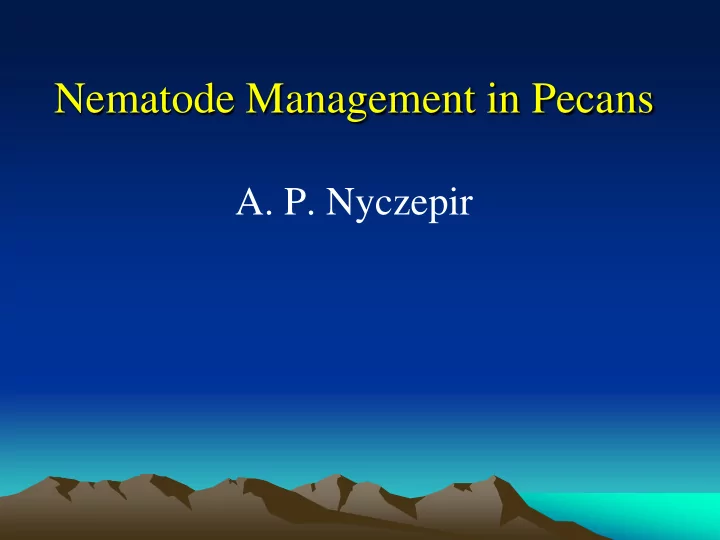

Nematode Management in Pecans A. P. Nyczepir
Collaborators • Bruce Wood, USDA-ARS • Janete Brito, FL Dept. Agric. Cons. Serv. • Don Dickson, Univ. Florida
HISTORY ( Meloidogyne partityla on Pecan) (Pecan Root-Knot Nematode) • 1986 – 1 st reported in South Africa. • 1996 – 1 st report in US (TX). • 2001 – 2 nd report in US (NM). • 2002 – 3 rd report in US (GA). • 2005 – 4 th report in US (FL) • 2006 – 5 th report in US (AZ & OK)
ABOVE-GROUND SYMPTOMS ( M. partityla on Pecan) • Dead branches in upper canopy. • Some trees severely stunted.
BELOW-GROUND SYMPTOMS ( M. partityla on Pecan) Typical root galls Mature female
IDENTIFICATION ( M. partityla on Pecan) • Protein Analysis (USDA – Byron) (see below) • DNA Analysis (NM State Univ.)
Distribution of M. partityla in Georgia • In 2003-04, a survey was conducted in the major pecan growing regions of Georgia. • Root samples infested with root-knot nematode were obtained from 13 different commercial pecan production sites. • M. partityla was the predominant root-knot nematode found; occurring in 72% of the orchards sampled.
Nyczepir, Reilly, & Wood, 2004
Influence of M. partityla (Mp) on severity of ME symptoms of pecan. Uninoculated Mp-alone M. partityla is a contributing factor to promoting “Nickel” deficiency in pecan. Nyczepir et al., 2006
CONTROL ( M. partityla on Pecan) • Chemical – no effective control (Temik). • Cultural – unknown to date. • Rootstock – unknown to date. • Biological – unknown to date.
OBJECTIVE ( M. partityla on Pecan) • Determine the susceptibility of 9 selected pecan rootstocks to M. partityla . • Determine the susceptibility of 5 selected peach rootstocks to M. partityla .
METHODS ( M. partityla on Pecan) • Open pollinated seedling stocks evaluated: – Apache - Pawnee - Moneymaker – Caddo - Schley – Curtis - Stuart – Elliott - Wichita
METHODS ( M. partityla on Pecan) • Root-Knot Nematodes evaluated: – M. partityla (Pecan root-knot). – M. incognita (Southern root-knot). – M. arenaria (Peanut root-knot). • 1,400 eggs per pot
METHODS ( M. partityla on Pecan) • Data recorded after ~160 days: – No. egg masses per root system. – No. root galls per root system. – No. eggs per root system.
RESULTS ( M. partityla on Pecan) • Regardless of rootstock, there were more (P < 0.05) egg masses & galls per root system assoc. with M. partityla vs. Mi & Ma. • Pecan is a better host for Mp than either Mi or Ma.
RESULTS ( M. partityla on Pecan) • All pecan rootstocks “Elliot” tested supported greater (P < 0.05) numbers of M. partityla than Mi or Ma • M. partityla reproduces better on pecan than either Mi or Ma. Egg/g root Eggs/mass
METHODS ( M. partityla on Peach) • Peach seedling stocks evaluated: Nemaguard Lovell Guardian Halford Flordaguard
METHODS ( M. partityla on Peach) • 1,500 eggs per pot • Elliott pecan (Control) • Data recorded after ~127 days: – No. egg masses per root system. – No. root galls per root system. – No. eggs per root system.
RESULTS ( M. partityla on Peach) • All peach rootstocks were rated as non- hosts (highly resistant) to M. partityla infection. • Number M. partityla eggs per plant • All peach stocks (0 eggs/plant) • Elliott (>17,000 eggs /plant) Nyczepir and Wood, 2012
Field Microplot Study OBJECTIVE: Conduct a long-term field evaluation study to determine if ‘Curtis’ or ‘Elliott’ tree growth is impaired due to M. partityla infection.
Influence of M. partityla on Tree Growth Trunk Diameter (mm) Tree growth of both ‘Elliott’ & a b ‘Curtis’ rootstocks was suppressed in the presence of M. partityla 2 years after inoculation.
CONCLUSIONS • All open pollinated pecan seedlings tested were good hosts to M. partityla . • All peach rootstocks tested were non-hosts to M. partityla. • Interplanting pecan & peach trees in a commercial orchard does not appear to intensify M. partityla populations between these 2 crops. • Growth suppression was observed at the same level in both ‘Curtis‘ & ‘Elliott’ stocks in the presence of M. partityla .
Biological Control
Pasteuria penetrans Is an endospore-forming bacterial parasite. Has been shown to have great potential as a biocontrol agent of root-knot nematodes. Has never been evaluated against the pecan root-knot nematode, M. partityla .
OBJECTIVE Determine if Pasteuria penetrans can effectively suppress populations of M. partityla on pecan.
METHODS • Evaluate three (3) different Pasteuria isolates for parasitism against of M. partityla (GA-pecan isolate) in the laboratory. • Bacteria endospores of the most promising isolates will then be increased and re-evaluated under field microplot conditions at USDA-Byron.
RESULTS • Laboratory results have identified specific P. penetrans isolates that have exhibited attachment & efficacy against the juveniles of pecan root-knot nematode. A B C M. partityla juvenile
METHODS A B 1) Nematode-alone (Mp) (4,000 eggs/pot) 2) Both organisms (Mp + Bacteria (720,000 spores/pot) 3) Control
Tree Growth Tree Death (2013) - Control = 0% - Mp+Pp = 8% - Mp-alone = 42% Trunk Diam. (mm) a ab b a ab b
SUMMARY The findings of this research indicate that the Pecan Root-Knot Nematode is: 1. A potentially economically important pathogen to the pecan industry in the SE United States. 2. The search for an IPM management strategy (i.e., rootstock, biological, chemical, etc.) for control of this nematode pest on pecan is warranted.
Recommend
More recommend